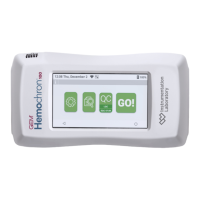1 - Introduction
18 / 112
000HZ6006EN.US • 02 • GEM Hemochron 100 Operator Manual
1.7
Limitations
Test results are aected by poor technique during blood collection and delivery to the sample well. The
accuracy of the test result is largely dependent upon the quality of the blood sample, which is dependent upon
the technique used to collect the blood sample and to transfer the blood to the test cartridge. For specic
limitations, refer to the package insert for the individual assay.
As with all diagnostic tests, GEM Hemochron 100 test results should be evaluated in the context of a specic
patient’s condition and anticoagulant therapy. Any test results exhibiting inconsistency with the patient’s
clinical status should be repeated or supplemented with additional test data. Samples with a hematocrit less
than 20% or greater than 55% are not recommended, due to an optical density outside the detection level of
the instrument.
1.8
Specications
Specications for the GEM Hemochron 100 instrument are listed below:
Dimensions and Weight:
Length: 18.8 cm (7.4 inches)
Width: 10.2 cm (4.0 inches)
Height: 5.1 cm (2.0 inches)
Weight: 0.68 kg (1.5 lbs.)
Operation:
Memory Capacity: Instrument memory stores 10,000 test results (patient, LQC, and EQC tests)
Battery Life: 500 charges for a full new battery
Battery Type: Lithium-ion
Battery Power: 7.2 VDC, 20.88 Wh
Operating Environment: 15°C–30°C (59°F–86°F), 20–85% RH (non‑condensing), Elevation of 0–3,094 meters
(10,151 feet)
Testing Environment: Indoors, on a dry, clean, horizontal, and stable surface
Time to Test Results: ~4 minutes from sample introduction
Test Cartridge Incubation
Temperature:
37°C ± 1.0°C (96.8°F–100.4°F)
Test Cartridge Incubation
Warm-Up Time:
30–90 seconds
Power Supply:
Input Power: 100–240 VAC, 50/60 Hz, 1–0.5 A
Output Power: +12 VDC, 3.34 A, 40W MAX
Storage and Transport:
Storage Environment: ‑20°C–55°C (‑4°F–131°F), < 85% RH (non‑condensing)
Calibration:
The GEM Hemochron 100 instrument is calibrated at the manufacturing facility to test and verify all functions.
The instrument is also self‑verifying, as all instrument functions are monitored and veried by the instrument
software before each patient or LQC test is run. The instrument does not require additional calibration by the
user.

